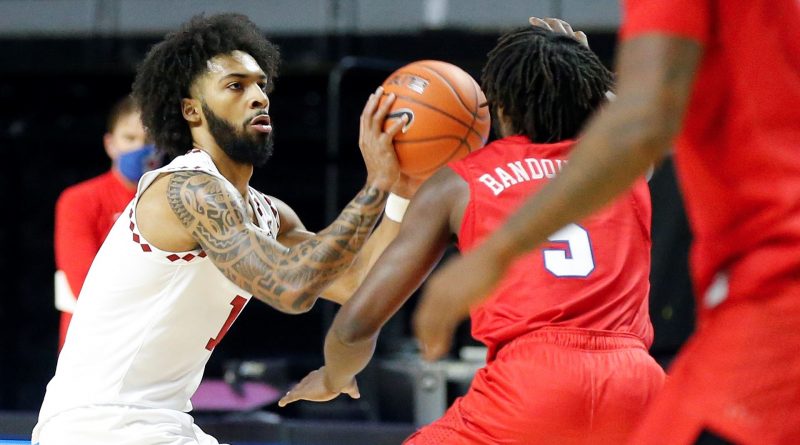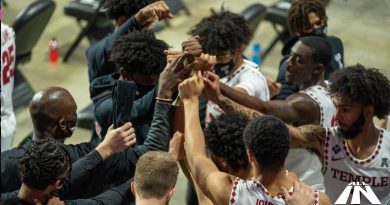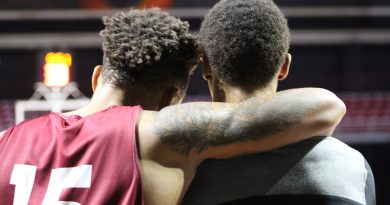Backcourt produces a mixed bag of results as Owls fall to SMU to begin 2021
Photo courtesy: Zamani Feelings
At some point throughout the ESPN+ broadcast of Monday’s game between Temple (1-3, 0-3 in AAC) and SMU (7-2, 3-2), they flashed a graphic with the American Athletic Conference standings. At first glance, viewers realize the Owls are at the bottom, winless in conference play and in last place.
The longer the graphic remains on the screen, the story of the season becomes more obvious. The Owls were in the midst of their fourth game of the season, a far cry from the double digit amounts of games that eight of the other eleven teams in the conference have played.
The young Owls team were finally back on the floor but the lack of experience and game reps for the team showed as they fell 79-68 to SMU in Dallas on Monday afternoon. After sticking around for about thirty minutes, SMU put together a mid-second half run that would provide enough distance to secure the win.
“It’s experience,” McKie said of an Owls’ loss eerily similar to those that have come before it. “(SMU is) playing an experienced point guard (Kendric Davis) who’s been playing a lot of minutes who is able to control games. We have a freshman…those guys are learning.”
In the four games the Owls have played this season, they are only being outscored by two points in the first half. The second half, however, has been brutal. They’ve been outscored by 31 points and are allowing opponents to shoot 41% from beyond the arc. McKie mentioned postgame that there the team had something to be desired in their defensive rotations, allowing the Mustangs to pick up their three point production in the second half.
As for the experienced guard play, it’s been trial by fire for the young Owls’ backcourt since they’ve reached conference play. After locking up the AAC’s leading scorer, Kendric Davis, in their first matchup just under two weeks ago, Davis had the Owls figured out this time around. He scored 20 points in the victory and dished out eight assists.
“We’re progressing everyday. Everything for us is a new lesson learned, of course we’re looking to win,” Damian Dunn said postgame. “It starts with every one of us having the mindset that we’re going to take baby steps in order to get this win.”
Dunn and Brendan Barry led the team in scoring with 17 points apiece. Dunn was complacent early on, settling for some jumpers in the first half before really getting into his game of attacking the basket in the second half. As for Barry, he was the storyline in the first half.
Barry knocked down all five of his three pointers in the game’s opening minutes, keeping the Owls in it as the offense was sputtering. SMU keyed in on him in the second half, limiting him to just two points from the charity stripe. Still, the early returns on the Dartmouth transfer have been incredible.
In the small sample size of the team’s first four games, Barry is:
- Top ten of NCAA Division 1 college basketball in three point percentage (56%)
- On pace for a Temple record 112 threes in a 32 game season
- Shooting nearly nine percentage points higher than Lynn Greer’s all-time three point record for a season (47.1%)
For anyone, that’d be quite a start. For a player that only arrived on campus last month in the middle of a pandemic and sat out last season due to injury, it’s somewhat insane. His numbers at Dartmouth suggest a drop off to something more sustainable, but still impressive, like the 44.5% he shot in his three seasons as a member of the Big Green. That figure, of course, would be a career record had it come at Temple (current holder is Nate Blackwell, 40.5% from 1983-1987).
The spacing, which at so many times a season ago was frustrating at best, has been improved with him as opponents have to respect his willingness to shoot. Given his early success and the seamless fit, McKie was asked whether or not he believed Barry would start in the postgame. He didn’t rule it out, but pointed to the fact that Barry played 33 minutes off the bench, more than all but one of the Owls’ starters.
With more playing time, however, teams are seeing plenty of him and able to adjust like SMU did on Monday. Since conference play opened up, the Owls are 11-of-47 (23.4%) from beyond the arc when Barry is not the one shooting the rock. The rest of the team finding its shot is of the utmost importance moving forward.
“We have to use him as more of a decoy when that happens,” McKie said postgame. “Teams are not going to allow him to just stand out there and shoot. Other guys are going to step up and make shots.”
At his best, Barry can keep the Owls afloat in games as they figure things out offensively and serve as a leading presence for a roster in desperate need of one. The problem remains that he shouldn’t have to buoy the rest of the team for the entire season. Stops and starts are a necessity for safety, but a hindrance to any cohesiveness that this team develops.
This backcourt will be tested in the coming weeks time and time again. A summer lost to a pandemic, a slew of starts and stops as well as the gauntlet of talented backcourts in the AAC all stand in the way of victory for them. Progress, however, is measured in another way.
Freshman Quincy Ademokoya played big minutes for the first time and showed some flashes of the scorer he may become while seemingly being engaged defensively. Damian Dunn continued to cut down on the turnovers and showed his ability to draw contact yet again. On the other end, Jeremiah Williams had a difficult afternoon and Tai Strickland didn’t see a ton of action.
It’s all about the give and take of progress in a year that’s taken so much.




